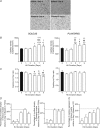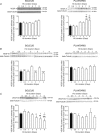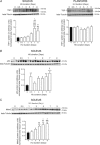Angio-adaptation in unloaded skeletal muscle: new insights into an early and muscle type-specific dynamic process
- PMID: 20876198
- PMCID: PMC3008859
- DOI: 10.1113/jphysiol.2010.193243
Angio-adaptation in unloaded skeletal muscle: new insights into an early and muscle type-specific dynamic process
Abstract
With a remarkable plasticity, skeletal muscle adapts to an altered functional demand. Muscle angio-adaptation can either involve the growth or the regression of capillaries as respectively observed in response to endurance training or muscle unloading. Whereas the molecular mechanisms that regulate exercise-induced muscle angiogenesis have been extensively studied, understanding how muscle unloading can in contrast lead to capillary regression has received very little attention. Here we have investigated the consequences of a 9 day time course hindlimb unloading on both capillarization and expression of angio-adaptive molecules in two different rat skeletal muscles. Both soleus and plantaris muscles were atrophied similarly. In contrast, our results have shown different angio-adaptive patterns between these two muscles. Capillary regression occurred only in the soleus, a slow-twitch and oxidative postural muscle. Conversely, the level of capillarization was preserved in the plantaris, a fast-twitch and glycolytic muscle. We have also measured the time course protein expression of key pro- and anti-angiogenic signals (VEGF-A, VEGF-B, VEGF-R2, TSP-1). Our results have revealed that the angio-adaptive response to unloading was muscle-type specific, and that an integrated balance between pro- and anti-angiogenic signals plays a determinant role in regulating this process. In conclusion, we have brought new evidence that measuring the ratio between pro- and anti-angiogenic signals in order to evaluate muscle angio-adaptation was a more accurate approach than analysing the expression of molecular factors taken individually.
Figures





Similar articles
-
Striated muscle angio-adaptation requires changes in Vasohibin-1 expression pattern.Biochem Biophys Res Commun. 2010 Aug 27;399(3):359-64. doi: 10.1016/j.bbrc.2010.07.076. Epub 2010 Jul 24. Biochem Biophys Res Commun. 2010. PMID: 20659423
-
Time course of capillary regression and an expression balance between vascular endothelial growth factor-A and thrombospondin-1 in the soleus muscle of hindlimb unloaded rats.Muscle Nerve. 2022 Mar;65(3):350-360. doi: 10.1002/mus.27478. Epub 2022 Jan 8. Muscle Nerve. 2022. PMID: 34957570
-
Expression of angiogenic regulators and skeletal muscle capillarity in selectively bred high aerobic capacity mice.Exp Physiol. 2011 Nov;96(11):1138-50. doi: 10.1113/expphysiol.2011.057711. Epub 2011 Jul 31. Exp Physiol. 2011. PMID: 21804139
-
Importance of anti-angiogenic factors in the regulation of skeletal muscle angiogenesis.Microcirculation. 2011 May;18(4):316-30. doi: 10.1111/j.1549-8719.2011.00092.x. Microcirculation. 2011. PMID: 21418382 Review.
-
Advances and challenges in skeletal muscle angiogenesis.Am J Physiol Heart Circ Physiol. 2016 Feb 1;310(3):H326-36. doi: 10.1152/ajpheart.00635.2015. Epub 2015 Nov 25. Am J Physiol Heart Circ Physiol. 2016. PMID: 26608338 Free PMC article. Review.
Cited by
-
Chronic delivery of a thrombospondin-1 mimetic decreases skeletal muscle capillarity in mice.PLoS One. 2013;8(2):e55953. doi: 10.1371/journal.pone.0055953. Epub 2013 Feb 6. PLoS One. 2013. PMID: 23405239 Free PMC article.
-
Intermittent whole-body vibration attenuates a reduction in the number of the capillaries in unloaded rat skeletal muscle.BMC Musculoskelet Disord. 2014 Sep 26;15:315. doi: 10.1186/1471-2474-15-315. BMC Musculoskelet Disord. 2014. PMID: 25260531 Free PMC article.
-
(-)-Epicatechin is associated with increased angiogenic and mitochondrial signalling in the hindlimb of rats selectively bred for innate low running capacity.Clin Sci (Lond). 2013 Jun;124(11):663-74. doi: 10.1042/CS20120469. Clin Sci (Lond). 2013. PMID: 23252598 Free PMC article.
-
Non-Invasive and Quantitative Evaluation for Disuse Muscle Atrophy Caused by Immobilization After Limb Fracture Based on Surface Electromyography Analysis.Diagnostics (Basel). 2024 Nov 29;14(23):2695. doi: 10.3390/diagnostics14232695. Diagnostics (Basel). 2024. PMID: 39682606 Free PMC article.
-
Leg immobilization and subsequent recovery resistance training affect skeletal muscle angiogenesis related markers in young healthy adults regardless of prior resistance training experience.bioRxiv [Preprint]. 2024 Nov 26:2024.11.24.625075. doi: 10.1101/2024.11.24.625075. bioRxiv. 2024. Update in: J Appl Physiol (1985). 2025 Jul 1;139(1):81-90. doi: 10.1152/japplphysiol.00988.2024. PMID: 39651155 Free PMC article. Updated. Preprint.
References
-
- Alway SE, Lowe DA, Chen KD. The effects of age and hindlimb supension on the levels of expression of the myogenic regulatory factors MyoD and myogenin in rat fast and slow skeletal muscles. Exp Physiol. 2001;86:509–517. - PubMed
-
- An WG, Kanekal M, Simon MC, Maltepe E, Blagosklonny MV, Neckers LM. Stabilization of wild-type p53 by hypoxia-inducible factor 1α. Nature. 1998;392:405–408. - PubMed
-
- Bellomo D, Headrick JP, Silins GU, Paterson CA, Thomas PS, Gartside M, Mould A, Cahill MM, Tonks ID, Grimmond SM, Townson S, Wells C, Little M, Cummings MC, Hayward NK, Kay GF. Mice lacking the vascular endothelial growth factor-B gene (Vegfb) have smaller hearts, dysfunctional coronary vasculature, and impaired recovery from cardiac ischemia. Circ Res. 2000;86:E29–35. - PubMed
-
- Blagosklonny MV, Giannakakou P, Wojtowicz M, Romanova LY, Ain KB, Bates SE, Fojo T. Effects of p53-expressing adenovirus on the chemosensitivity and differentiation of anaplastic thyroid cancer cells. J Clin Endocrinol Metab. 1998;83:2516–2522. - PubMed
-
- Booth FW, Thomason DB. Molecular and cellular adaptation of muscle in response to exercise: perspectives of various models. Physiol Rev. 1991;71:541–585. - PubMed
Publication types
MeSH terms
LinkOut - more resources
Full Text Sources
Miscellaneous

